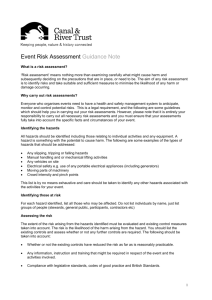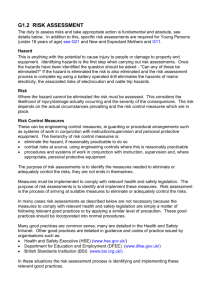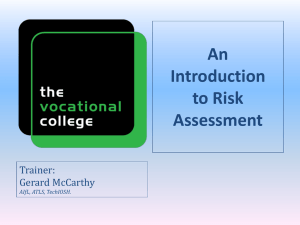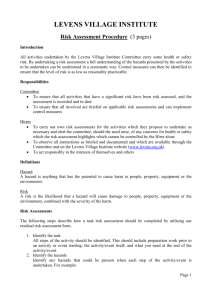6. Procedure for Risk Assessment
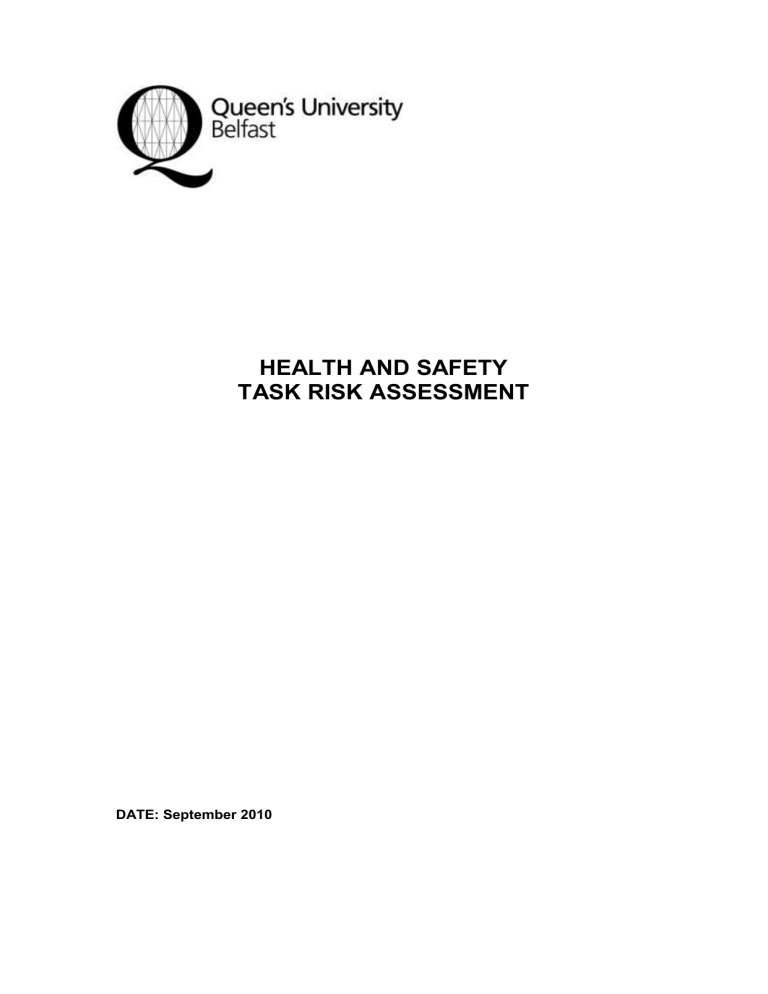
HEALTH AND SAFETY
TASK RISK ASSESSMENT
DATE: September 2010
Index
General Policy on Health and Safety Risk Assessment ...................................... 3
Management Responsibility ....................................................................... 3
Employee/Student Responsibility ............................................................... 4
Communication, Co-Operation and Co-Ordination ............................................. 4
6.1 Identification of the operation or activity ……………………………………....4
6.2 Identification of the hazards…………………………………………………….4
6.3 Assessment of the risk…………………………………………………………..4
6.4 Identification of the persons at risk……………………………………………..5
6.5 Determination of the necessary contr ol or preventative measures…………6
6.6 Assessment of the residual risk………………………………………………...6
6.7 Recording of the assessment…………………………………………………..6
6.8 Communication of the assessment…………………………………………….7
6.9 Reviewin g the assessment……………………………………………………...7
7. Training…………………………………………………………………………………..7
4.
1.
2.
3.
General Policy on Health and Safety Risk Assessment
Management at all levels must ensure that all significant hazards within their area of responsibility are identified, properly assessed and that the risks are eliminated or controlled so far as is reasonably practicable. Appropriate information, instruction, training and supervision must be provided to staff, students and others who may be affected. Risk assessments must be reviewed at suitable intervals or when any significant change takes place.
Scope
This policy is applicable to the risk assessment of the health and safety risks associated with the day-to-day tasks and activities or the working environment of a School or Directorate.
Once completed, Local Risk Assessments provide information for Schools and Directorates to conduct a high level strategic health and safety risk assessment exercise for the School/Directorate and to include health and safety in the School/Directorate Risk Register. The strategic health and safety risk assessment process is outlined in the Management Health and Safety
Risk Assessment Policy.
This local risk assessment system should be used where possible as a standard method unless it is considered inappropriate. If an equivalent system has been previously used it is not necessary to rewrite assessments but consideration should be given to change to the standard system at a future date.
There are specific risk assessment procedures for certain activities such as manual handling, display screen equipment, COSHH, noise, lone working etc.
Where a separate procedure exists, that procedure should be used.
Authorisation
All activities conducted within Schools and Directorates must have the authorisation of management i.e. the Director/Principal Investigator/Head of
Unit/Division etc. following suitable and sufficient risk assessment and inclusion of the activities in the Risk Registers.
Responsibility
4.1 Management Responsibility
Heads of School/Directors are responsible for ensuring that risk assessment is conducted at all levels within their School/Directorate and that Risk Registers are maintained.
Heads of Departments and Units are responsible for ensuring that task risk assessments are conducted within areas under their control and that the content of risk assessments are communicated to staff and students as appropriate. They should also ensure that Safety
6.
Representatives, where appointed, are included in the risk assessment process.
4.2 Employee/Student Responsibility
Employees and students are required to participate in the risk assessment process when requested, to make themselves familiar with the contents of risk assessments and for co-operating with the measures contained within the assessments for controlling and managing the risks to health and safety.
5. Communication, Co-operation and Co-ordination
Risk assessments must be clearly communicated as appropriate to management, employees and students. Management must ensure that assessments are brought to the attention of staff and students on a periodic basis particularly following any changes or significant review.
Procedure for Risk Assessment
The main elements of Risk Assessment are:
Identification of the operation or activity
Identification of the hazards
Assessment of the risk
Identification of the persons at risk
Determination of the necessary control or preventative measures
Assessment of the residual risk
Recording the assessment
Communication of the assessment
Reviewing the assessment
6.1 Identification of the operation or activity
The scope of the assessment must be clearly defined. Activities should be broken down into clear operations or tasks. It is common for some activities to require several risk assessments.
6.2 Identification of the hazards
A hazard is something with the potential to cause harm (physical injury or ill health). Hazards arise from activities, from the use of equipment or the use or production of hazardous substances. A list of key words useful in identification of hazards is provided in Appendix 1.
6.3 Assessment of the Risk
Risk is comprised of two elements, the likelihood of harm occurring and the severity of that harm. In risk assessment, the likelihood of harm is the estimated frequency of the harm occurring and severity is the estimated seriousness of the potential to cause harm. A subjective estimate of both must be made. Opinions will vary and it is good
practice for assessments to be undertaken by a group so that a consensus of opinion and an average of the estimates obtained.
Hazard severity should be rated on a scale of 1 to 4.
1 – Very Minor (Trivial effect or very minor first aid attention required)
2 – Minor (Likely to require first aid or minor medical attention, short term effect)
3 – Significant (Significant injury or condition, may result in lost time)
4 – Major (Serious injury or condition, may have long term effects)
Likelihood of harm occurring should be rated on a scale of 1 to 4
1 – Unlikely (Unlikely to occur but not impossible)
2 – Possible (Less likely to occur than not to occur)
3 – Likely (More likely to occur than not to occur)
4 – Very Likely (Very likely though not necessarily certain to occur)
The factors for severity and likelihood are multiplied together to give the risk rating. This value will help evaluate the risk as to whether the risk is controlled to the required level.
A general rating of the level of risk can be made depending on the score achieved:
Severity
Very Minor
Minor
Significant
Major
Probability Risk Rating
Unlikely Possible Likely Very Likely Score Risk Level
1
2
3
4
2
4
6
8
3
6
9
12
4
8
12
16
1-2
3-6
8-9
12-16
Low
Medium
High
Very High
LOW (1 – 2)
MEDIUM
HIGH
(3 - 6)
(8 – 9)
VERY HIGH (12 – 16)
The risk rating enables decisions to be taken on the amount of effort to be expended on the control of a risk, but any hazard that is certain or very likely to cause injury must be attended to and the risk reduced even if the severity is low.
All risks must be controlled so far as is reasonably practicable. The term reasonably practicable is interpreted as the balance between the risk, and the cost and difficulty or inconvenience involved in controlling it.
6.4 Identification of the Persons at Risk
When undertaking a risk assessment, all persons who are at risk of being harmed should be identified. This may not only include those carrying out the task but other persons in the vicinity including other staff, students, visitors, contractors, members of the public and
trespassers. The number of persons at risk should be taken into consideration.
The risk assessment should also take into account, where necessary, other risk factors such as age, gender, health, young persons, and children, those with impairments or disabilities and new or expectant mothers.
6.5 Determination of the Necessary Control and Preventative Measures
Management must ensure that the most appropriate and effective method or methods of risk control are utilised in eliminating or managing risks. Where appropriate and as far as is reasonably practicable, the hierarchy of risk control measures listed below should each be considered and applied in the order given. In many cases a suitable combination of control methods may be necessary.
Elimination of hazard
Substitution with lower hazard or risk
Enclosure
Guarding/Segregation
Safe Systems of Work
Written Procedures
Supervision
Training
Information/Instruction
Personal Protective Equipment
6.6 Assessment of the Residual Risk
The risk to health and safety of a task should be assessed with all the necessary control measures in place to establish the net or residual risk. The risk should be reduced to Low or to As Low As Reasonably
Practicable (often referred to as ALARP). If the risk is not Low or As
Low As Reasonably Practicable, consideration should be given to additional control measures to reduce the risk further.
Once the risk has been reduced to As Low As Reasonably
Practicable, any remaining risk should be highlighted in the assessment so that it can be communicated to those affected or responsible for implementing any of the control measures.
6.7 Recording the Assessment
The risk assessment must be recorded (electronic methods are acceptable). A general form is available for this purpose (see the
Safety Service website). All significant details and findings must be included though reference may be made to other documents such as procedures rather than reproducing them in full.
9.
8.
7.
6.8 Communication of the Assessment
The information contained within the assessment must be communicated with those staff and students who may be affected by the work. For assurance purposes it is good practice to keep a record of when and how the assessments have been communicated.
Information about the risks may also need to be communicated to other people e.g. to members of the public through signage and other staff such as safety representatives or auditors who will require access to the information from time to time.
6.9 Reviewing the Assessment
Risk assessment should be seen as a continual process. Risk assessments must be reviewed and kept up to date to take account of changes in processes and work methods, new staff or changes to other activities or hazards.
In addition, a general periodic review of all assessments must be undertaken. There is no set period for general review though 6 to 12 months is often advised. A general review date should be recorded as
Training part of the assessment.
Anyone undertaking a risk assessment must have received appropriate training and have sufficient knowledge and understanding of the assessment process. Input is often required from others during the risk assessment process. Whilst it is not necessary for everyone to be trained, anyone involved should receive a briefing or an overview of the process from a competent person.
Record Keeping
Records of risk assessments should be kept for at least seven years. Some assessments in connection with medical records and health surveillance may have to be kept for forty years.
Monitoring/Audit
Schools/Directorates should monitor the compliance of this policy and take appropriate action where necessary. Records of risk assessment, instruction and training, maintenance events etc. should be made available for audit by internal/ external auditors.
10. Regulations & Guidance
Management of Health and Safety at Work Regulations (Northern Ireland)
2000 (SR2000/388)
Management of Health and Safety at Work - Management of Health and
Safety at Work Regulations 1999, Approved Code of Practice & Guidance
(L21)
Risk Assessment Simplified (HSENI 99 11-A)
Five Steps to Risk Assessment (INDG 163 rev2)
A Guide to Risk Assessment
(INDG 218 and 218L)
– Common Provisions in Health and Safety Law
11. Appendices
Appendix 1 - Hazards List
Appendix 2
Appendix 3
– Sample Risk Assessments
– Task Risk Assessment Form
Hazard List
1. Access
Slips, trips and falls
Falling or moving objects
Obstructions or projections
Confined spaces
2. Handling & Lifting
3. Fire & Explosion
4. Electricity
5. Workplace Factors
Noise
Vibration
Light
Humidity
Ventilation
Temperature
Pressure/Vacuum
6. Transport
7. Mechanical
Entanglement
Friction/abrasion
Cutting
Shearing
Stabbing/puncturing
Impact
Crushing/trapping
Ejection
8. Chemical
Toxic
Irritant
Sensitising
Flammable
Corrosive
Explosive
Carcinogenic
9. Particles and Dust
Inhalation
Ingestion
Abrasion of skin or eye
Appendix 1
10. Biological
Bacterial
Viral
Fungal
11. Radiation
Ionising
Non-ionising
12. Organisational
Poor maintenance
Lack of supervision
Lack of training
Lack of information
Unsafe systems
Unsuitable equipment
13. Individual
Not suited to work
High work rate
Unsafe behaviour


